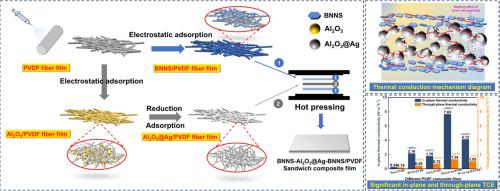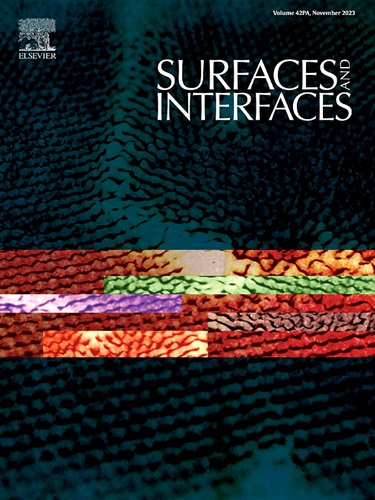Simultaneously improving in-plane and through-plane thermal conductivity of insulted PVDF composite film using multi-layer and multi-filler strategies
IF 5.7
2区 材料科学
Q2 CHEMISTRY, PHYSICAL
引用次数: 0
Abstract
In this paper, a multi-filler synergistic strategy combined with multi-layer hot pressing technology was developed to optimize the thermal conductivity and insulation properties of composite materials. Boron nitride nanosheets (BNNS), aluminium oxide (Al2O3) microspheres and silver (Ag) nanoparticles were incorporated to construct a three-dimensional thermal conduction network within a polyvinylidene fluoride (PVDF) thermally conductive composite film. An electrospun PVDF fiber film was first prepared to be used as a template. BNNS and Al2O3 were then electrostatically assembled on the surface of the PVDF fiber and in the film to obtain continuous BNNS/PVDF fiber film and Al2O3/PVDF fiber film, respectively. Ag nanoparticles were then prepared in situ on the Al2O3/PVDF fiber film to obtain an Ag-enhanced Al2O3/PVDF fiber film. A sandwich structured PVDF composite film (B-A@Ag-B/PVDF) was finally prepared by hot pressing, using the BNNS/PVDF fiber films as the top and bottom layers and the Ag-enhanced Al2O3/PVDF fiber film as the middle layer. The resulting B-A@Ag-B/PVDF composite film, with a total filler mass fraction of 32.1 %, had in-plane and through-plane thermal conductivities of 4.13 W m–¹ K–¹ and 1.05 W m–¹ K–¹, respectively, improvements of 1620 % and 452 % compared to those of pure PVDF. In addition, the through-plane electrical conductivity was as low as 5.38 × 10–¹¹ S/cm, matching the standards for insulating materials. The B-A@Ag-B/PVDF composite film demonstrates significant potential for advanced thermally conductive polymer composites.

采用多层和多填料策略,同时提高了受冲击PVDF复合膜的面内和透面导热性
为了优化复合材料的导热性能和保温性能,提出了一种结合多层热压技术的多填料协同策略。采用氮化硼纳米片(BNNS)、氧化铝(Al2O3)微球和银(Ag)纳米颗粒在聚偏氟乙烯(PVDF)导热复合膜内构建了三维热传导网络。首先制备了静电纺PVDF纤维薄膜作为模板。然后将BNNS和Al2O3静电组装在PVDF纤维表面和膜内,分别得到连续的BNNS/PVDF纤维膜和Al2O3/PVDF纤维膜。然后在Al2O3/PVDF纤维膜上原位制备Ag纳米粒子,得到Ag增强的Al2O3/PVDF纤维膜。以BNNS/PVDF纤维膜为上、下两层,ag增强Al2O3/PVDF纤维膜为中间层,采用热压法制备了夹层结构PVDF复合膜(B-A@Ag-B/PVDF)。所得B-A@Ag-B/PVDF复合膜的面内导热系数为4.13 W m -¹K -¹,面内导热系数为1.05 W m -¹K -¹,与纯PVDF相比,分别提高了1620%和452%。通过面电导率低至5.38 × 10 -¹¹S/cm,符合绝缘材料标准。B-A@Ag-B/PVDF复合膜显示了先进导热聚合物复合材料的巨大潜力。
本文章由计算机程序翻译,如有差异,请以英文原文为准。
求助全文
约1分钟内获得全文
求助全文
来源期刊

Surfaces and Interfaces
Chemistry-General Chemistry
CiteScore
8.50
自引率
6.50%
发文量
753
审稿时长
35 days
期刊介绍:
The aim of the journal is to provide a respectful outlet for ''sound science'' papers in all research areas on surfaces and interfaces. We define sound science papers as papers that describe new and well-executed research, but that do not necessarily provide brand new insights or are merely a description of research results.
Surfaces and Interfaces publishes research papers in all fields of surface science which may not always find the right home on first submission to our Elsevier sister journals (Applied Surface, Surface and Coatings Technology, Thin Solid Films)
 求助内容:
求助内容: 应助结果提醒方式:
应助结果提醒方式:


